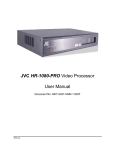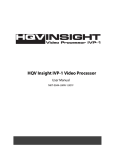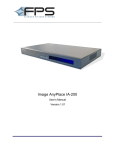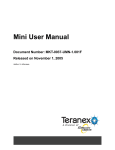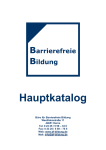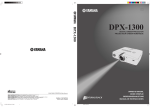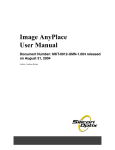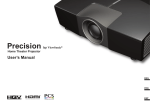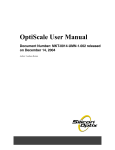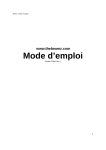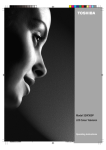Download NEC TheaterSync Video Processor User's Manual
Transcript
NEC TheaterSync Video Processor User Manual Document No. MKT-0026-UMN-1.002F NEC Solutions, Inc. MKT-0026-UMN-1.002F TheaterSync Video Processor User Manual Copyright and Trademark Information Portions copyright © 2005 Silicon Optix Inc All Rights Reserved. Portions of the information contained in this document are protected by worldwide copyright. All rights are reserved by Silicon Optix Incorporated. Product names mentioned herein are used for identification purposes only and may be trademarks of their respective companies. Silicon Optix™, eWARP™, AnyPlace™, Hollywood Quality Video (HQV™), and REALTA™ are trademarks of Silicon Optix Inc. HQV® and REALTA® are also registered trademarks of Silicon Optix Inc. in USA. Page 2 NEC Solutions, Inc. TheaterSync Video Processor User Manual MKT-0026-UMN-1.002F Table of Contents 1 Preface.....................................................................................................................................4 1.1 1.2 1.3 1.4 Limited Warranty .............................................................................................................. 4 Related Documents............................................................................................................ 6 FCC Statement .................................................................................................................. 6 Safety................................................................................................................................. 7 2 Introduction...........................................................................................................................10 2.1 General Description......................................................................................................... 10 3 Installation.............................................................................................................................14 3.1 List of Standard Components .......................................................................................... 14 3.2 Setting up your TheaterSync ........................................................................................... 14 4 TheaterSync User Interface .................................................................................................16 4.1 IR Remote Control .......................................................................................................... 16 4.2 TheaterSync Operational Modes ..................................................................................... 17 5 On-Screen Menu ...................................................................................................................22 5.1 OSM Menu Structure ...................................................................................................... 22 5.2 Aspect Ratio .................................................................................................................... 30 6 Appendix A............................................................................................................................36 NEC Solutions, Inc. Page 3 MKT-0026-UMN-1.002F TheaterSync Video Processor User Manual 1 Preface 1.1 Limited Warranty NEC Solutions (America), Inc. warrants this product to be free from defects in material and workmanship under the following terms and, subject to the conditions set forth below, agrees to repair or replace (at NEC Solutions’ sole option) any part of the enclosed unit which proves defective. Replacement parts or products may be new or refurbished and will meet specifications of the original parts or products. HOW LONG IS THE WARRANTY? Parts and labor are warranted for (1) one year from the date of the first customer purchase. WHO IS PROTECTED? This warranty may be enforced only by the first purchaser. WHAT IS COVERED AND WHAT IS NOT COVERED Except as specified below, this warranty covers all defects in material or workmanship in this product. The following are not covered by the warranty: 1. Any product which is not distributed in the U.S.A. or Canada by NEC Solutions or which is not purchased in the U.S.A. or Canada from an authorized NEC Solutions dealer. 2. Any product of which the serial number has been defaced, modified, or removed. 3. Damage, deterioration or malfunction resulting from: a. Accident, misuse, abuse, neglect, fire, water, lightning or other acts of nature, unauthorized product modification, or failure to follow instructions supplied with the product. b. Repair or attempted repair by anyone not authorized by NEC Solutions. c. Any shipment of the product (claims must be presented to the carrier). d. Removal or installation of the product. e. Any other cause which does not relate to a product defect. f. Burns or residual images upon the phosphor of the panel. 4. Cartons, carrying cases, batteries, external cabinets, magnetic tapes, or any accessories used in connection with the product. 5. Service outside of the U.S.A. and Canada. Page 4 NEC Solutions, Inc. TheaterSync Video Processor User Manual MKT-0026-UMN-1.002F WHAT WE WILL PAY FOR AND WHAT WE WILL NOT PAY FOR We will pay labor and material expenses for covered items, but we will not pay for the following: 1. Removal or installation charges. 2. Costs of initial technical adjustments (set-up), including adjustment of user controls. These costs are the responsibility of the NEC Solutions dealer from whom the product was purchased. 3. Shipping charges. HOW YOU CAN GET WARRANTY SERVICE 1. To obtain service on your product, consult the dealer from whom you purchased the product. 2. Whenever warranty service is required, the original dated invoice (or a copy) must be presented as proof of warranty coverage. When mailing the request for service, always include your name, address, and a description of the problem(s). 3. For the name of the nearest NEC Solutions authorized service center, call NEC Solutions at 800-836-0655. LIMITATIONS OF LIABILITY Except for the obligations specifically set forth in this warranty statement, we will not be liable for any direct, indirect, special, incidental, consequential, or other types of damages, whether based on contract, tort, or any other legal theory, whether or not we have been advised of the possibility of such damages. This warranty is in lieu of all other warranties expressed or implied, including, but not limited to, the implied warranties of merchantability or fitness for a particular purpose. EXCLUSION OF DAMAGES NEC Solutions’ liability for any defective product is limited to the repair or replacement of the product at our option. NEC Solutions shall not be liable for: 1. Damage to other property caused by any defects in this product, damages based upon inconvenience, loss of use of the product, loss of time, commercial loss; or 2. Any other damages whether incidental, consequential or otherwise. Some states do not allow limitation on how long an implied warranty lasts and/or do not allow the exclusion or limitation of incidental or consequential damages, so the above limitations and exclusions may not apply to you. NEC Solutions, Inc. Page 5 MKT-0026-UMN-1.002F TheaterSync Video Processor User Manual HOW STATE LAW RELATES TO THE WARRANTY This warranty gives you specific legal rights, and you may also have other rights which vary from state to state. FOR MORE INFORMATION, TELEPHONE 800-836-0655 NEC SOLUTIONS (AMERICA), INC. 1250 N. Arlington Heights Road, Suite 500 Itasca, Illinois 60143-1248 Note: All products returned to NEC Solutions (America), Inc. for service MUST have prior approval. To get approval, call NEC Solutions (America), Inc. at 800-836-0655. 1.2 • 1.3 Related Documents TheaterSync Service Manual FCC Statement Note: This equipment has been tested and found to comply with the limits for Class B digital devices, pursuant to Part 15 of the FCC Rules. These limits are designed to provide reasonable protection against harmful interference in a residential/office installation. The equipment generates uses and can radiate radio frequency energy and, if not installed and used in accordance with the instructions, may cause harmful interference to radio communications. However, there is no guarantee that interference will not occur in a particular installation. If this equipment does cause harmful interference to radio or television reception, which can be determined by turning the equipment off and on, the user is encouraged to try to correct the interference by one or more of the following measures: • • • • • Page 6 Reorient or relocate the receiving antenna. Increase the separation between the equipment and receiver. Connect the equipment into an outlet on a circuit different from that to which the receiver is connected. Consult the dealer or an experienced Radio/TV technician for help. Changes or modifications not expressly approved by the party responsible for compliance could void the user's authority to operate the equipment. NEC Solutions, Inc. TheaterSync Video Processor User Manual 1.4 MKT-0026-UMN-1.002F Safety 1.4.1 Important Safety Instructions This symbol warns the user of uninsulated voltage within the unit that can cause dangerous electric shocks. TO REDUCE THE RISK OF FIRE OR ELECTRIC SHOCK, DO NOT REMOVE COVER. NO USER SERVICEABLE PARTS INSIDE. REFER SERVICING TO QUALIFIED SERVICE PERSONNEL. TO REDUCE THE RISK OF FIRE OR ELECTRIC SHOCK, DO NOT EXPOSE THIS APPLIANCE TO RAIN OR MOISTURE. This symbol alerts the user that there are important operating and maintenance instructions in the literature accompanying this unit. Read the User Guide carefully and completely before operating the unit. Be sure to keep the User Guide in a near-at-hand location for future reference. Strictly follow all warnings and cautions in this User Guide, as well as the following safety suggestions. To prevent electric shock or injury, follow these safety instructions in the installation, use, and servicing the unit. 1.4.2 Installation Attachments - Do not use attachments not recommended by the manufacturer, as they may result in the risk of fire, electric shock, or injury to persons. Water and Moisture - Do not use this unit near water; for example, near a bathtub, washbasin, kitchen sink or laundry tub, in a wet basement, or near a swimming pool, water spa, or the like. Heat - Do not use this unit near sources of heat, including heating vents, stoves, or other appliances that generate heat. Also, do not place this product in temperature environments greater than 45oC (104oF). Mounting Surface - If not installing the unit in a standard equipment rack using the recommended mounting brackets, place the unit on a flat, even surface. Do not place the unit on an unstable cart, stand, tripod, bracket, or table. The unit may fall causing serious injury to a person and/or serious damage to the appliance. NEC Solutions, Inc. Page 7 MKT-0026-UMN-1.002F TheaterSync Video Processor User Manual Portable Cart - An appliance and cart combination should be moved with extreme care. Quick stops, excessive force, and uneven surfaces may cause the appliance and cart combination to overturn. Ventilation - Locate the unit with adequate space around it so that proper heat ventilation is assured. Allow 10 cm (4 in) clearance from the rear and top of the unit, and 5 cm (2 in) from each side. Slots and openings in the unit's case are provided for ventilation to ensure reliable operation of the unit and to prevent overheating. These openings must not be blocked or covered. The openings should never be blocked by operating the unit while placed on a bed, sofa, rug, or similar surface. This unit should not be placed in a built-in installation such as a bookcase unless adequate ventilation is provided. Entry of Foreign Objects and Liquids - Never push foreign objects of any kind into this unit through the ventilation slots as they may touch dangerous voltage points or short-circuit electrical/electronic parts that could result in fire, or electric shock, or both. Never spill liquid of any kind onto the unit. Electric Power - Only operate the unit from the type of electric power source indicated on the unit's labeling. If you are not sure of the type of power supply that is available in your home or workplace, consult your appliance supplier or local power company. Grounding or Polarization - This unit is provided with a 3-pin, grounded, alternating current line plug. This plug will fit into the power outlet only one way. This is a safety feature. Do not try to defeat the safety purpose of the plug. Power Cord Protection - Route power supply cords so that they are not likely to be walked on or pinched by placing items upon or against them, paying particular attention to cords at plugs, convenience receptacles, and the point where they exit from the product. Overloading - Do not overload wall power outlets, extension cords, or integral convenience receptacles as this can result in a risk of fire or electric shock. Lightning - For added protection for this unit during a lightning storm, or when it is left unattended and unused for long periods of time, unplug it from the power outlet. This will prevent damage to the unit due to lightning or power surges. 1.4.3 Maintenance Cleaning - Unplug this unit from the wall outlet before cleaning. Do not use liquid cleaners or aerosol cleaners. Only use a soft cloth dampened with a mild detergent solution. Do not use strong solvents such as alcohol, benzene, or paint thinner. Damage Requiring Service - Unplug this unit from the power outlet and refer servicing to qualified service personnel under the following conditions: • Page 8 When the power cord or plug is damaged. NEC Solutions, Inc. TheaterSync Video Processor User Manual MKT-0026-UMN-1.002F • • • If liquid has been spilled or foreign objects have fallen into the unit. If the unit has been exposed to rain or water. If the unit does not operate normally, following the operating instructions. Adjust only those controls that are covered by the operating instructions as improper adjustment of other controls may result in damage and may require extensive work by a qualified technician to restore the unit to normal operation. • If the unit has been dropped or the case has been damaged. • When the unit exhibits a distinct change in performance - this indicates a need for service. Do not attempt to service this unit yourself as opening or removing covers may expose you to dangerous voltage or other hazards. Refer all servicing to qualified service personnel. NEC Solutions, Inc. Page 9 MKT-0026-UMN-1.002F TheaterSync Video Processor User Manual 2 Introduction 2.1 General Description The NEC TheaterSync (see Figure 1) is a high performance video signal processor intended as a companion for plasma and projector displays. TheaterSync brings the power of Silicon Optix HQVTM (“Hollywood Quality Video”TM) technology to viewers of plasma and projector displays. Initially conceived in the military research labs of Lockheed Martin and then refined and commercialized by Teranex and Silicon Optix, HQV video processing has been the technology of choice of film and video professionals in broadcast and studio environments for years. A breakthrough in cost reduction and packaging now enables this revolutionary technology - previously found only in Professional Post Production, Film Editing and Broadcast Studios – to be delivered to your home or business viewing environment. Figure 1: NEC TheaterSync Video Processor As a video signal processor, TheaterSync receives the video signals generated by a wide variety of consumer electronic and professional devices, switches between them, and applies HQV signal processing to the selected signal (see Figure 2). The processed signal is then scaled to the appropriate resolution and aspect ratio of the plasma panel, projector, or other display device. HQV signal processing includes the following powerful features: • • • • • • • • State-of-the-art, motion-adaptive de-interlacing for both SDTV and HDTV Temporal Recursive Noise Reduction Codec Noise Reduction (includes mosquito noise reduction and block artifact removal) Detail Enhancement Fully-automatic detection and correction for multiple film/video cadences (3:2, 2:2, varispeed, 6:4, 8:7, etc.) AnyPlaceTM technology for extreme off-axis keystone correction Brightness-Contrast Enhancement Color Space Conversion and Color Temperature Adjustment For more information on HQV technology, visit http://www.hqv.com. Page 10 NEC Solutions, Inc. TheaterSync Video Processor User Manual MKT-0026-UMN-1.002F Figure 2: Typical TheaterSync Application TheaterSync also performs a number of useful signal processing functions such as high-quality video scaling, switching, extreme keystone correction and audio delay, thus eliminating the requirement for stand-alone scalers or audio delay units within your system. TheaterSync offers access to a truly wide range of signal inputs – everything from SDTV (composite, S-Video and component) to HD-SDI and all popular video and computer graphics signals in between (including analog RGB, DVI, and HDMI) may be selected as inputs. TheaterSync provides video output in HDMI, DVI and analog RGB formats on dedicated connectors. All this functionality can be controlled through a simple 20-button IR remote control unit (see Figure 5). Simple navigation keys bring access to a simple, yet elegant OSM (On-Screen Menu). Video input device selection is accomplished using dedicated IR remote buttons. Access to the HQV features is also provided through dedicated IR remote buttons. Also, TheaterSync provides the professional user with flexible control methodologies of RS-232, USB and Ethernet. For details on the control programming protocol, refer to the TheaterSync Service Manual. The TheaterSync video processor is available in a compact and attractive desktop package that can be rapidly fitted to a standard 19” rack using a rack mounting kit (included). NEC Solutions, Inc. Page 11 MKT-0026-UMN-1.002F TheaterSync Video Processor User Manual Features and Specifications Input Video Signals ¾ Composite Video (NTSC, PAL and SECAM) ¾ S-Video (NTSC and PAL) ¾ Component (YPbPr for SDTV and HDTV in American and European formats) ¾ Analog RGB (VGA to SXGA60Hz) ¾ DVI (VGA to QXGA) ¾ HDMI ¾ SDI (including HD-SDI and audio) Output Video Signals ¾ Analog RGB (VGA to UXGA) ¾ DVI (VGA to QXGA) ¾ HDMI Input Audio Signals ¾ S/PDIF ¾ Toslink ¾ HDMI Output Audio Signals ¾ S/PDIF ¾ Toslink ¾ HDMI Video and Audio Processing Capability ¾ Scaling ¾ Extreme Keystone Correction (+/- 40o horizontal, +/- 30o vertical) ¾ Audio Delay ¾ Input Switching ¾ Aspect Ratio Correction ¾ HQV Video Processing … • Temporal-Recursive Noise Reduction • Codec Noise Reduction • Fully-automatic cadence detection and correction • Detail Enhancement • Advanced motion-adaptive de-interlacing Control ¾ IR Remote Control ¾ RS-232 ¾ USB (for connection to Crestron / AMX boxes) ¾ Ethernet Page 12 NEC Solutions, Inc. TheaterSync Video Processor User Manual MKT-0026-UMN-1.002F Physical Characteristics Dimensions: 17.0” x 9.7” x 1.75” (43.2 x 24.6 x 4.4 cm) Weight : 7 lbs. (3.2 kg) Power: 100-240V, 47-63 Hz, 72W Panel Diagrams Figure 3: TheaterSync Front Panel Drawing Figure 4: TheaterSync Rear Panel Drawing NEC Solutions, Inc. Page 13 MKT-0026-UMN-1.002F TheaterSync Video Processor User Manual 3 Installation 3.1 List of Standard Components The TheaterSync processor ships with a number of standard components. When unpacking your unit, verify that the following items are included: • • • • • 3.2 TheaterSync unit (qty 1) IEC-320 American AC power cord (qty 1) Infrared remote control (qty 1) Rack-mount adapter kit (qty 1) TheaterSync User Manual (qty 1) Setting up your TheaterSync To set up your TheaterSync unit, follow the steps below: 1. Connect the TheaterSync unit to the video input sources. 2. Connect the TheaterSync unit to the display device. NOTE: If you are connecting to a panel or projector that supports the coding of HDCP encrypted material on its DVI input, you must connect to that DVI input using TheaterSync’s HDMI OUT connector (and an HDMI to DVI adapter). 3. To power up the unit, press the Power switch located on the rear of the unit, close to the power cord. The Power switch may be left on in normal operation. The On/Setup button on the front panel may be used to put the unit into a low-power state (Setup Mode). NOTE: When TheaterSync is in Setup (Stand-by) Mode, the output to the projector or panel is temporarily suspended. 4. Select the output resolution to match the native resolution of the display device: a) Place the unit in Setup (Stand-by) Mode by toggling the Operate/Setup button on the IR remote (or by using the On/Setup button on the unit’s front panel). b) Using the up/down arrow keys of the remote, cycle through the different setup modes (which will be displayed on the box LCD display) until the output resolution mode is selected (“OUT = xxx” will appear on the LCD display, where ‘xxx’ is the current active output resolution) c) Using the left/right arrow keys, select the desired output resolution. 5. Return TheaterSync to Operate Mode by pushing the On/Setup button on the front panel or the Power button on the IR Remote. This activates the TheaterSync output circuits. Further adjustments may be made using the TheaterSync OSM (On-Screen Menu). Page 14 NEC Solutions, Inc. TheaterSync Video Processor User Manual MKT-0026-UMN-1.002F For projection applications where keystone correction is required, continue with the following steps: 6. If the projector has an AUTOSET or AUTODETECT feature, disable this function. These projector modes may cause image distortion if a keystone-corrected image is applied to the projector input. 7. Select the “Advanced” menu from the TheaterSync OSM, then select “Projection”, and “Horizontal and Vertical Keystone” submenus. 8. Using the up/down arrow keys, select in turn each of the image corner sliders and then use the left/right arrow keys to move the corner to the desired location on the screen. Continue adjustments until the projected image matches the target screen geometry. NEC Solutions, Inc. Page 15 MKT-0026-UMN-1.002F TheaterSync Video Processor User Manual 4 TheaterSync User Interface 4.1 IR Remote Control All TheaterSync user interface controls are accessed via infrared (IR) remote control. The remote has three groups of controls: a) OSM Navigation (including the Operate/Setup Key), b) Video Source Selection, and c) HQV Feature Selection. You may also select video sources and HQV processing features through the OSM navigation controls, however dedicated IR remote keys provide you with quick one-touch access to the most frequently used commands. Figure 5 illustrates the TheaterSync remote control. Figure 5: TheaterSync Remote Control A description of the various buttons and their functions is as follows: Page 16 NEC Solutions, Inc. TheaterSync Video Processor User Manual MKT-0026-UMN-1.002F The Operate/Setup button toggles the TheaterSync between “Operate” and “Setup” modes of operation (as described in the next section of this User Interface chapter). The Menu button is used to invoke the OSM main menu. The Up/Down/Left/Right Arrow buttons are used to navigate the OSM. The Enter/Select button is used to activate an OSM menu selection. Direct (one-touch) input selection is possible using the buttons below: • • • • • • • The RGB button selects the VGA port as the active input. The DVI button selects the DVI port as the active input. The Video button selects the composite video port as the active input. The S-Video button selects the S-Video port as the active input. The YPbPr button selects component video as the active input. The HDMI button selects HDMI as the active input. The SDI button selects the SDI port as the active input Additional buttons are available to directly access key video processing features and to cycle through the available enhancements: • • • • • • 4.2 The BCE button activates/deactivates the Brightness / Contrast Enhancement feature The Aspect Ratio button cycles through and selects the available aspect ratio treatments available for the current input and output mode combination (for description of aspect ratio treatments, see section 5.2) The TRNR button accesses the Temporal Recursive Noise Reduction feature, cycling through the four available settings (Off, Low, Medium, and High) The CNR button accesses the Codec Noise Reduction feature, cycling through the four available settings (Off, Low, Medium, and High) The Film button cycles through the three available film mode treatments for active video (Auto Film/Video mode detect, Force to Video mode, Force to Film mode) The Split button activates/deactivates a split-screen mode for direct comparison of the image with and without noise reduction activated. TheaterSync Operational Modes TheaterSync has two operational modes, Operate and Setup. These modes are selected by a dedicated key on the IR remote. TheaterSync also enables selection of the Operate Mode with RS-232, USB, or Ethernet. NEC Solutions, Inc. Page 17 MKT-0026-UMN-1.002F TheaterSync Video Processor User Manual 4.2.1 Operate Mode Operate Mode is entered by toggling the Operate/Setup button on the IR remote. A brief transition of about 3 seconds occurs when Operate Mode is entered. During this transition period, the 24 x 2 LCD Display indicates THEATERSYNC Please Wait In Operate Mode, the video output signals are activated and you may control all of TheaterSync parameters with the remote control (except for Setup restricted parameters, as noted below). The LCD front panel display indicates the following information in its 24 x 2 character matrix: (Selected Input Connector) = (Input Signal Detected) Output = (Output Resolution currently selected) Depending on which IR remote key that you select, the operation of the OSM is slightly different. If you select the Menu key, the TheaterSync OSM appears on the screen. Complete details on the OSM may be found in chapter 5. The OSM remains on the screen until you press the Menu key once again or until 30 seconds with no IR remote activity passes. If you select one of the dedicated HQV Feature keys, the HQV feature is immediately activated. A brief message indicating the status of the selected HQV feature appears momentarily on the screen (e. g. TRNR = Medium or CNR = Off). If you select one of the Input Source keys, the selected source is chosen as the input. The previously selected HQV Features, Aspect Ratio Treatment, Scaling and Video Parameters are all preserved for each input; each input will appear exactly as you left it. TheaterSync powers up in Operate mode. All operational parameters are retained from the previous session. A Factory Reset returns all parameters to the default state (defaults are described in chapter 5), except for the input signal. The input signal most recently used is retained as the power-up input signal. 4.2.2 Setup (Stand-by) Mode Setup mode is entered by toggling the Operate/Setup button on the IR remote. In Setup mode TheaterSync is in a low-power state. The output signals are de-activated (no output will appear on your display device). Setup mode enables you to power the unit down, but still leaves the IR receiver circuitry energized so that you can re-start the system with the IR remote. When the unit is in Setup Mode, you can also make adjustments to certain sensitive Page 18 NEC Solutions, Inc. TheaterSync Video Processor User Manual MKT-0026-UMN-1.002F parameters, such as Output Resolution. Visual feedback for the adjustments of Setup Mode is seen on the 24 x 2 LCD display, rather than on OSM of the main screen. Sensitive parameters are placed in the Setup Menu so that an inadvertent key stroke with the IR remote does not cause a change in a parameter that would be difficult to recover from. Table 1 lists the Setup parameters and Table 2 lists the output resolutions currently supported in the unit. Table 1: Setup Parameters Parameter OUT = XXX ## Hz LCD Brightness = On (Off) Output Sync = Free Run (Vadjust 1:1, Vjam) BAUD = ##### OSM Location = Input (Output) Description 1 Cycles through all of the available TheaterSync output modes (see Table 2 for a list of Output Resolutions). Turns On (Off) the 24 x 2 LCD Display during Operate Mode These settings enables to adjust the output sync: Free Run – Establishes a precise output timeline Vadjust 1:1 – Forces the output timeline to be frame locked to the input by inserting or deleting entire lines of output video Vjam – Maintains frame lock by truncating final line of output frame Lets you choose a baud rate of 1200, 9600, 19200, 57600, or 115000. The OSM may be located pre (Input side) or post (Output side) scaling and keystone correction PC Control = Active (Inactive) Turns On (Off) the computer control capability DHCP = On (Off) Turns on Dynamic IP Address Selection IP=aaa.bbb.ccc.ddd Select IP Address (selectable only if DHCP = Off) DNS=aaa.bbb.ccc.ddd Select DNS Address (selectable only if DHCP = Off) 2nd DNS=aaa.bbb.ccc.ddd Select Alternate DNS Address (selectable only if DHCP = Off) Gateway=aaa.bbb.ccc.ddd Select Gateway Address (selectable only if DHCP = Off) SubMask=aaa.bbb.ccc.ddd Select SubNet Mask (selectable only if DHCP = Off) Serial No = ###### Indicates the Serial # of TheaterSync unit MAC = ## ## ## ## ## ## Indicates the MAC Address of TheaterSync unit 1 The default parameters configurations are highlighted in bold. NEC Solutions, Inc. Page 19 MKT-0026-UMN-1.002F TheaterSync Video Processor User Manual Table 2: TheaterSync Output Modes Output Mode VGA 60 Hz (640 x 480) VGA 50 Hz (640 x 480) 848 x 480 60 Hz SVGA 60 Hz (800 x 600) SVGA 50 Hz (800 x 600) 720p 60 Hz (1280 x 720) 720p 50 Hz (1280 x 720) XGA 72 Hz (1024 x 768) XGA 60 Hz (1024 x 768) XGA 50 Hz (1024 x 768) 1360 x 768 60 Hz 1365 x 768 60 Hz 1400 x 788 60 Hz SXGA 60 Hz (1280 x 1024) SXGA 50 Hz (1280 x 1024) SXGA+ 60 Hz (1400 x 1050) SXGA+ 50 Hz (1400 x 1050) 1080p 60 Hz (1920 x 1080) 1080p 50 Hz (1920 x 1080) 1080p 48 Hz (1920 x 1080) QXGA 60 Hz (2048 x 1536) QXGA 50 Hz (2048 x 1536) QXGA 48 Hz (2048 x 1536) Comments VESA Standard VESA Standard / VESA Standard VESA Standard SMPTE Standard SMPTE Standard VESA Standard VESA Standard VESA Standard / / / VESA Standard VESA Standard VESA Standard VESA Standard SMPTE Standard SMPTE Standard SMPTE Standard / / / On entry to setup mode, the 24 x 2 LCD display indicates the following: THEATERSYNC Setup Select the Menu key on your IR Remote to bring up the Setup Menu on the 24 x 2 LCD display. The LCD display will indicate the following: “Parameter” = ??? Setup Mode Using the Up and Down navigation keys on the remote, you can select the next parameter in a circular list of parameters. Using the Left and Right navigation keys on the remote, you can select the value of the parameter. In some cases, the parameter is visible in the setup menu, but may not be altered (such as Serial Number or MAC Address). Selection of IP addresses is slightly different. IP addresses may only be selected if the DHCP parameter has been set to “Off”. In this case, you use the Left or Right navigation key to “enter” the IP address. The Left key will highlight the rightmost octet; the Right key will select the Page 20 NEC Solutions, Inc. TheaterSync Video Processor User Manual MKT-0026-UMN-1.002F leftmost octet. The Up/Down keys may then be used to increase/decrease the value of the octet. Subsequent presses of the Left/Right key will highlight the octet immediately to the left/right. The Up/Down keys may then be used to increase/decrease the value of the octet. When the leftmost/rightmost octet is selected, an additional Left/Right key selection will “exit” the IP address. The Up/Down arrows may then be used to select the next parameter. Table 1 lists the Setup parameters. NEC Solutions, Inc. Page 21 MKT-0026-UMN-1.002F TheaterSync Video Processor User Manual 5 On-Screen Menu 5.1 OSM Menu Structure The On-Screen Menu (OSM) is the primary way of controlling and selecting functions in the TheaterSync system. When first powered up, the TheaterSync will be in a Factory Default configuration, with English as the OSM language, Component Video as Video Input, and S/PDIF Audio as Audio input. All other Factory Default parameters are indicated in Table 4. When the user selects the Factory Reset from the OSM menu, TheaterSync reloads all of these default parameters, replacing any adjustments previously made. Certain parameters are not affected by the Factory Reset and are left in their most recently selected position. These parameters are: Language, Selected Input, and Selected Audio Input. As indicated in chapter 4, the Setup Parameters are not affected by Factory Reset. TheaterSync remembers all the signal processing parameters on a selected input basis. When the user powers down or selects a different input, the processing parameters previously selected are automatically re-established when returning to that input. An Input Reset sets the currently selected input to its default parameters. (This allows the user to reset a specific input channel without disturbing selections that affect the entire TheaterSync operation). A complete view of the OSM menu structure is shown in Table 3 and Table 4. Table 3: OSM Main Menu Structure Icon ON OFF Descriptio n Inputs Enter this submenu to select the video or audio input. Picture Enter this menu to adjust the image brightness, contrast, sharpness, gamma correction, black level, color temperature, color, hue, tint, and aspect ratio. Setup Enter this submenu to review the video system, select the background color, reset to default settings, and setup the menu position. Language Info Page 22 Functionality Enter this submenu to select the language used by the OSM. Enter this submenu to view information about the system (input resolution, horizontal and vertical frequency, output resolution, horizontal and vertical frequency, firmware revision, FPGA revision, serial number, and IP address). NEC Solutions, Inc. TheaterSync Video Processor User Manual Icon ON OFF MKT-0026-UMN-1.002F Descriptio n Advanced Functionality Enter this submenu to access the advanced menu options. Table 4: OSM Complete Menu Structure OSM Menu Level Level 1 Level 2 Video Comments Level 3 Component VGA DVI S-Video Composite SDI HDMI Level 4 - Level 5 - TosLink - - S/PDIF - - -100 - +100, 0 (default) - - Brightness 0 - 100, 50 (default) Contrast 0 - 100, 50 (default) Audio Inputs Audio Delay Picture - The higher the setting, the greater the brightness. The lower the setting, the lower the brightness. - The higher the setting, the greater the contrast. The lower the setting, the lower the contrast. Picture Settings NEC Solutions, Inc. HDTV or SDTV SDTV, HDTV, or Graphics Graphics, RGB HDTV SDTV SDTV SDI input selection HDMI input selection Selects TosLink as audio source Selects S/PDIF as audio source Adjusts the Audio Delay through TheaterSync. The Audio Delay is calibrated in milliseconds. A delay of ‘0’ selects a delay that is automatically adjusted to the number of frames of delay introduced by TheaterSync processing. The Audio Delay adjustment allows the user to compensate for Audio or Video delay that is introduced by other system components Page 23 MKT-0026-UMN-1.002F TheaterSync Video Processor User Manual OSM Menu Level Level 1 Level 2 Level 3 Comments Level 4 Level 5 Sharpness 0 - 100, 50 (default) - Detail Enhancement 0 - 100, 50 (default) - Gamma 1.0 (default) Input Gamma Picture Picture Settings Gamma Mode Output Gamma Gamma 1.5 Gamma LUT for non-linear response (1.5). Gamma 2.2 Gamma LUT for non-linear response (2.2). Gamma 2.4 Gamma LUT for non-linear response (2.4). Gamma 2.5 Gamma LUT for non-linear response (2.5). Gamma 2.8 Gamma LUT for non-linear response (2.8). Gamma 1.0 (default) Gamma LUT for linear response (1.0). Gamma 2.2 Gamma LUT for non-linear response (2.2). Gamma 2.4 Gamma LUT for non-linear response (2.4). Gamma 2.5 Gamma 2.8 Color Temp Color Page 24 The higher the setting, the sharper the image (edge enhancement). The lower the setting, the lower the sharpness. The higher the setting, the better the image (detail enhancement). The lower the setting, the lower the detail enhancement. Gamma LUT for linear response (1.0). 9300K - 6500K (default) - 5500K - 0 - 100, 50 (default) - Gamma LUT for non-linear response (2.5). Gamma LUT for non-linear response (2.8). Gives a blue tint to the white colors. Gives a neutral tint to the white colors. Gives a red tint to the white colors. The higher the setting, the greater the intensity. The lower the setting, the lower the intensity. NEC Solutions, Inc. TheaterSync Video Processor User Manual MKT-0026-UMN-1.002F OSM Menu Level Level 1 Level 2 Comments Level 3 Level 4 Level 5 Hue 0 - 360, 180 (default) - Input Reset Confirm YES/NO - Standard (default) - - Full Screen - - Zoom - - Picture Settings Picture Aspect Ratio NEC Solutions, Inc. The higher the setting, the more greenish the picture. The lower the setting, the more purplish the picture. Returns all of the adjustments for a single input to the Factory Default state. All the other inputs and selections that affect the TheaterSync operation (such as Keystone Correction) are unaffected Maintains the aspect ratio: • 4:3 input and 16:9 output Output image would be displayed with black pillar bars (maintains input aspect ratio) • 4:3 input and 4:3 output No change • 16:9 input and 16:9 output No change • 16:9 input and 4:3 output Output image would be displayed with black letter box bars (maintains input aspect ratio) Fills the Output Screen by stretching the image (distorting the aspect ratio): • 4:3 input and 4:3 output – Grayed out, no action • 4:3 input and 16:9 output – Image is linearly stretched horizontally to fill the output screen • 16:9 input and 4:3 output Image is linearly stretched vertically to fill the output screen • 16:9 input and 16:9 output – Grayed out, no action See section 5.2 for more information. Fills the Output Screen by cropping the image (maintaining aspect ratio). • 4:3 input and 4:3 output – Grayed out, no action • 4:3 input and 16:9 output – Top and bottom portions of the image are cropped Page 25 MKT-0026-UMN-1.002F TheaterSync Video Processor User Manual OSM Menu Level Level 1 Level 2 Level 3 Comments Level 4 Level 5 • Picture Anamorphic - - Stadium - - Vertical 0 - 100 - Horizontal 0 - 400 - Autosync - - - Sync Clock 0 - 200, 100 (default) - Aspect Ratio Picture Position Page 26 16:9 input and 4:3 output – Left and right portions of the image are cropped • 16:9 input and 16:9 output – Grayed out, no action See section 5.2 for more information. This mode is used with DVDs (Standard Definition) that are in Widescreen [16:9] format: • 4:3 input and 4:3 output – The image is letter boxed • 4:3 input and 16:9 output – The image appears full screen • 16:9 input and 4:3 output – Grayed out, no action • 16:9 input and 16:9 output – Grayed out, no action See section 5.2 for more information. Fills the Output Screen by stretching the image (distorting the aspect ratio): • 4:3 input and 4:3 output – Grayed out, no action • 4:3 input and 16:9 output – Image is non-linearly stretched horizontally to fill the output screen • 16:9 input and 4:3 output – Grayed out, no action • 16:9 input and 16:9 output – Grayed out, no action See section 5.2 for more information. Adjusts the vertical position of image (default setting depends on the input video/graphics source) Adjusts the horizontal position of image (default setting depends on the input video/graphics source) Automatically centers the image for graphic inputs Adjusts clock sync NEC Solutions, Inc. TheaterSync Video Processor User Manual MKT-0026-UMN-1.002F OSM Menu Level Level 1 Level 2 Level 3 Level 4 Level 5 Phase 0 - 100, 50 (default) - Adjusts clock phase - Sets the percentage of Overscan on the left edge Status Left Picture Overscan Off On 0.0 – 10.0 0.0 (default) - 0.0 – 10.0 0.0 (default) 0.0 – 10.0 0.0 (default) 0.0 – 10.0 0.0 (default) - Center - - Top Left - - Top Right - - Bottom Left - - Bottom Right - - - - - Off (default) On Off (default) On - Sets the OSM menu position in the top left corner of the display Sets the OSM menu position in the top right corner of the display Sets the OSM menu position in the bottom left corner of the display Sets the OSM menu position in the bottom right corner of the display Displays test pattern images on screen, with OSM off. Up- and down-arrows navigate user through all 10 available test patterns. Left-arrow key returns user to Test Pattern menu. - Right Top Bottom Menu Position Comments - - Setup Test Patterns 12 V Triggers Language Trigger A Trigger B Sets the percentage of Overscan on the right edge Sets the percentage of Overscan on the top edge Sets the percentage of Overscan on the bottom edge Sets the OSM menu position in the center of the display Factory Reset Confirm YES/NO - - Resets to default settings English - - - Selects the language for the OSM menus French - - - German - - - Italian - - - Spanish - - - NEC Solutions, Inc. Page 27 MKT-0026-UMN-1.002F TheaterSync Video Processor User Manual OSM Menu Level Level 1 Language Level 2 Level 3 Level 4 Level 5 Portuguese - - - Swedish - - - Russian - - - Japanese - - - - - - - - - - - - - - - Shows the source resolution - - - Shows the source H frequency Chinese Simplified Chinese Traditional Korean Info Page 28 Selects the language for the OSM menus Input Resolution Input H Frequency Input V Frequency Output Mode Output Resolution Output H Frequency Output V Frequency - - - Shows the source V frequency - - - Shows the display mode - - - Shows the display resolution - - - Shows the display H frequency - - - Shows the display V frequency Sync - - - Shows the synchronization type - - - - - - Firmware Revision Serial Number Advanced Comments Shows the firmware revision number Shows the board serial number. IP Address - - - Shows the IP address only if the Ethernet cable is connected to the board and the IP address has been assigned by DHCP FPGA Revision - - - Shows the current revision number for the FPGA code Standby Micro Rev. # - - - Shows the firmware revision number for the standby-mode microcontroller Projection Horizontal and Vertical Keystone Top Left H - Controls the horizontal position of the display top left corner Top Left V - Controls the vertical position of the video display top left corner NEC Solutions, Inc. TheaterSync Video Processor User Manual MKT-0026-UMN-1.002F OSM Menu Level Level 1 Level 2 Level 3 Advanced Horizontal and Vertical Keystone Projection Projection Mounting Video Processing Mode HQV Film Mode BCE Comments Level 4 Level 5 Bottom Left H - Bottom Left V - Top Right H - Top Right V - Bottom Right H - Bottom Right V - Front Tabletop (default) Front Ceiling - Controls the horizontal position of the video display bottom left corner Controls the vertical position of the video display bottom left corner Controls the horizontal position of the display top right corner Controls the vertical position of the display top right corner Controls the horizontal position of the video display bottom right corner Controls the vertical position of the video display bottom right corner Normal projection mode Compensate the image for ceiling-mounting scenario Compensate the image for projection from behind the screen Compensate the image for ceiling-mounted rear-projection scenario Rear Tabletop - Rear Ceiling - HQV On (default) - - Process main image in the TVP HQV Off (Bypass) - - Process main image in Overlay Scaler (bypass the TVP processor) Auto (default) - - The system automatically selects the best mode for deinterlacing (film or video) Video - - Forces to video mode for deinterlacing Film - - 2 - - Cinema - - Video Forces to film mode for deinterlacing Expands video range signals (16-235) linearly to full range output Provides Luma processing optimized for movies; expands video range signals. 2 Default for HDMI, Component, Composite, S-Video, and SDI inputs. NEC Solutions, Inc. Page 29 MKT-0026-UMN-1.002F TheaterSync Video Processor User Manual OSM Menu Level Level 1 Level 2 Comments Level 3 Level 4 Level 5 Vivid - - Dark Scene - - Bright Scene - - Graphics 3 - - Off - Low (default) - Med - High - Off (default) - Low - Medium - Select Codec Noise Reduction, medium level High - Select Codec Noise Reduction, high level - - Toggles the split screen mode Toggles the split screen mode BCE TRNR Advanced HQV Noise Reduction CNR Split 5.2 Off (default) On Enhances color, expands video range signals. Enhances detail in dark scenes, expands video range signals. Enhances detail in bright scenes, expands video range signals. Transfers full range input signals (0-255) to full range output Turns off Temporal Recursive Noise Reduction (TRNR) Select TRNR -- low bias setting Select TRNR -- medium bias setting Select TRNR -- high bias setting Turns off the Codec Noise Reduction Select Codec Noise Reduction, low level Aspect Ratio TheaterSync provides five different aspect ratio treatments. The operation mode of these treatments depends on the aspect ratio of the input channel and the output display. The TheaterSync assumes that the aspect ratio of input and output is consistent with the industry standard definition of the aspect ratio of the particular input signal and video mode. Output aspect ratio is thus determined by the resolution selected by the user in Setup Mode. Input aspect ratio is determined by the TheaterSync video mode recognition circuitry. Only two output aspect ratios are supported, 4:3 and 16:9 4 . 3 Default for DVI and Analog RGB inputs. The special case of 1280 x 1024 SXGA (an aspect ratio of 5:4) on output is treated as if it were 4:3. The output of a 1280 x 1024 display will be slightly distorted; circles will appear to be vertically oriented ovals. Since the Page 30 NEC Solutions, Inc. 4 TheaterSync Video Processor User Manual MKT-0026-UMN-1.002F Inputs considered to have 4:3 aspect ratio are: • Computer Graphics signals with a 4:3 aspect ratio appearing on the DVI and Analog RGB inputs • SDTV signals (NTSC and PAL derived) appearing on the Composite, S-Video, and Component inputs • SDTV signals (NTSC and PAL derived) appearing on the SDI input • SDTV signals (NTSC and PAL derived) appearing on the HDMI input Inputs considered to have 16:9 aspect ratio are: • Computer Graphics signals with a 16:9 aspect ratio appearing on the DVI and Analog RGB inputs • HDTV signals (480p, 720p, 1080i, 1080p) appearing on the Component input • HDTV signals (480p, 720p, 1080i, 1080p) appearing on the SDI input • HDTV signals (480p, 720p, 1080i, 1080p) appearing on the HDMI input The five aspect ratio treatments, Standard, Full Screen, Zoom, Anamorphic, and Stadium are intended to achieve different aspect ratio objectives, and therefore behave differently depending on which input and output aspect ratios are currently selected. The Aspect Ratio objectives are the following: • • • • • Standard: always displays the correct aspect ratio of the input picture; adds black bars at the top and bottom or sides of the picture to achieve this objective Full Screen: always fills the screen with the complete picture; linearly distorts the picture to achieve this objective Zoom: always fills the screen with the correct aspect ratio of the input picture; crops the picture’s top and bottom or sides to achieve this objective Anamorphic: intended to handle the specific case of 16:9 aspect ratio anamorphically encoded into a 4:3 aspect ratio signal (e. g. an NTSC DVD encoded with a 16:9 picture Stadium: intended to handle the specific case of a 4:3 input aspect ratio and 16:9 output aspect ratio Table 5 to Table 8 present the five aspect ratio treatments over the four different combinations of Input Aspect Ratio and Output Aspect Ratio. TheaterSync is intended for Widescreen processing, the 1280 x 1024 SXGA is not a frequently encountered case. Input of 1280 x 1024 will be treated as a pillar boxed 4:3 signal (i.e. it will have narrow black bars on the Right and Left); aspect ratio of the picture content will be undistorted. NEC Solutions, Inc. Page 31 MKT-0026-UMN-1.002F TheaterSync Video Processor User Manual Table 5: Aspect Ratio Treatments for 4:3 Input with 4:3 Output OSM Menu Name Description 4:3 input signals shown full screen on 4:3 output display Standard Full Screen Grayed out. No action. Zoom Same as “Standard” mode above. Anamorphic or widescreen encoded DVDs shown letterbox on 4:3 output display. These DVDs have 16:9 content that has been compressed and expanded vertically to fit the NTSC or PAL signal. Anamorphic Stadium Grayed out. No action. Table 6: Aspect Ratio Treatments for 4:3 Input with 16:9 Output OSM Menu Name Description 4:3 input signals are shown in a pillar box on the 16:9 output display Standard Full Screen Page 32 4:3 input is linearly stretched horizontally to fill the 16:9 screen NEC Solutions, Inc. TheaterSync Video Processor User Manual OSM Menu Name Zoom MKT-0026-UMN-1.002F Description Grayed out. No action. SDTV input is displayed on a full screen 16:9 output display Anamorphic 4:3 input signals are non-linearly stretched in the horizontal direction to fill 16:9 output displays. Horizontal and vertical scaling is equal in the middle, more horizontal stretching towards left and right sides to fill 16:9 outputs Stadium NEC Solutions, Inc. Page 33 MKT-0026-UMN-1.002F TheaterSync Video Processor User Manual Table 7: Aspect Ratio Treatments for 16:9 Input with 4:3 Output OSM Menu Name Description All HDTV inputs are assumed to be 16:9. HDTV input signals (1080i and 720p) are shown in a letterbox on the 4:3 output display Standard Image stretched vertically to fill full screen. Full Screen 16:9 HDTV input signals shown in 4:3 output display, cropped on left and right sides Zoom Page 34 Anamorphic Grayed out. No action. Stadium Grayed out. No action. NEC Solutions, Inc. TheaterSync Video Processor User Manual MKT-0026-UMN-1.002F Table 8: Aspect Ratio Treatments for 16:9 Input with 16:9 Output OSM Menu Name Description 16:9 input signals shown full screen on 16:9 output display Standard Full Screen Grayed out. No action. Zoom Grayed out. No action. Anamorphic Grayed out. No action. Stadium Grayed out. No action. NEC Solutions, Inc. Page 35 MKT-0026-UMN-1.002F TheaterSync Video Processor User Manual 6 Appendix A Table 9: Input Modes Supported Input Timing Format Input Video Source Item No. Mode Description Resolution Frequency 1 480i (NTSC) 720 x 485 60 Hz - - 2 576i (PAL) 720 x 576 50 HZ - 3 576i (SECAM) 720 x 576 50 Hz 4 480p 720 x 483 5 576p 6 7 Composite S-video Component YES YES YES YES YES - - YES YES YES YES - - - YES YES - - 60 Hz - YES YES - - YES - 720 x 576 50 Hz - YES YES - - YES - HDTV 720 Progressive 1280 x 720 60 Hz - YES YES - - YES YES HDTV 720 50 Hz Progressive 1280 x 720 50 Hz - YES YES - - YES - HDTV 1080 Interlaced at 60 Hz 1920 x 1080 60 Hz - YES YES - - YES YES HDTV 1080 Interlaced at 50 Hz 1920 x 1080 50 Hz - YES YES - - YES YES 10 1080p at 24 Hz 1920 x 1080 24 Hz - - - - - - YES 11 1080p at 25 Hz 1920 x 1080 25 Hz - - - - - - YES 12 1080p at 30 Hz 1920 x 1080 30 Hz - - - - - - YES 13 1080p at 24sF 1920 x 1080 48 Hz - - - - - - YES 14 1080p at 25sF 1920 x 1080 50 Hz - - - - - - YES 15 1080p at 30sF 1920 x 1080 60 Hz - - - - - - YES 16 DOS TEXT 640 x 400 70 Hz YES YES YES - - - - 8 9 Page 36 RGB DVI HDMI NEC Solutions, Inc. SDI TheaterSync Video Processor User Manual MKT-0026-UMN-1.002F Input Timing Format Item No. Mode Description 17 Input Video Source Resolution Frequency Composite S-video Component VGA at 60 Hz 640 x 480 60 Hz YES YES YES - - - - 18 SVGA at 75 Hz 800 x 600 75 Hz YES YES YES - - - - 19 848 x 480 848 x 840 60 Hz YES YES - - - - - 20 1024 x 576 1024 x 576 60 Hz YES YES - - - - - 21 XGA at 75 Hz 1024 x 768 75 Hz YES YES YES - - - - 22 SXGA at 75 Hz 1280 x 1024 76 Hz YES YES YES - - - - 23 1360 x 768 1360 x 768 60 Hz YES YES - - - - - 24 1365 x 768 1365 x 768 60 Hz YES YES - - - - - 25 SXGA+ 1400 x 1050 60 Hz YES YES - - - - - 26 UXGA 1600 x 1200 60 Hz - YES YES - - - - 27 WUXGA 1920 x 1200 60 Hz - YES - - - - - 28 QXGA 2048 x 1536 60 Hz - YES - - - - - 29 MAC II Normal 13in 640 x 480 67 Hz YES YES YES - - - - 30 MAC II Normal 16in 832 x 624 75 Hz YES YES - - - - - 31 MAC II Normal 19in 1024 x 768 75 Hz YES YES - - - - - 32 MAC II Normal 21in 1152 x 870 75 Hz YES YES YES - - - - 33 MAC 1440 x 960 96 Hz - YES - - - - - 34 MAC 20 1680 x 1050 88 Hz - YES - - - - - 35 MAC 23 1920 x 1200 76 Hz - YES - - - - - NEC Solutions, Inc. RGB DVI HDMI Page 37 SDI MKT-0026-UMN-1.002F Page 38 TheaterSync Video Processor User Manual NEC Solutions, Inc.






































